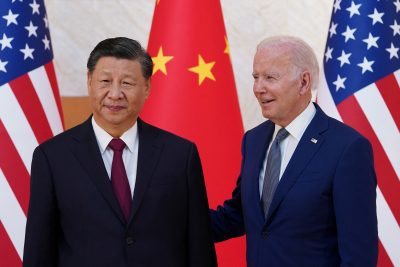Ryan Hass
At the start of 2022, China’s economy appeared strong, Beijing seemed to have contained the spread of COVID-19, Sino–Russian relations were deepening and there was growing talk of autocracies stealing the march on democracies across the world. China’s leaders were proclaiming that ‘time and momentum’ were on China’s side in its great power competition with the United States.
Meanwhile, the United States was mired in partisan paralysis, with President Joe Biden’s ‘Build Back Better’ agenda seemingly s-tuck. Washington was reeli-ng from the reputational da-mage of the United States’ chaotic withdrawal from A-fghanistan. Within Asia, ta-lk was growing louder of China dominating the 21st century.
A year later, the script reads differently. China’s economy has turned sluggish, pulled down by exp-anding state intervention in the economy, waves of COVID-related lockdowns, a property sector slowdown and softening international demand for Chinese ex-ports. Beijing’s messy exit from its zero-COVID policy has exacerbated domestic stressors. Even as China remains the largest trading partner for most of the world, its economic lustre has dimmed amid declining economic growth.
China’s international image in most of the developed world has also suffered. Part of this owes to China’s rhetorical support for Russia amid Moscow’s barbarism in Ukraine. China’s plummeting image is also attributable to its hardening authoritarianism at home, its nationalistic ‘wolf warrior’ diplomacy and its growing military activity along its periphery, including in the waters and airspace around Taiwan.
By comparison, Biden’s political position has stre-ngthened. At home, the B-iden administration secured passage of the bipartisan Infrastructure Investment and Jobs Act, the CHIPS and Science Act and the Inflation Reduction Act, which together add up to over US$1 trillion in government spending. Though elements of these investments favouring domestic manufacturing have generated friction with US trading partners, they represent a generational investment in US innovation. Techn-ology companies such as Taiwan Semiconductor Manufacturing Company, Samsung, Micron, SK Hynix, Intel and IBM announced investments in semiconductor production in the United States exceeding US$100 billion.
The United States also strengthened its position abroad. Transatlantic unity deepened under the stress of the joint response to Ru-ssia’s invasion of Ukraine. Coordination strengthened in other purpose-driven groupings, such as the Quad and AUKUS. The G7 bolstered its relevance as its members acted with greater cohesion on global challenges, including financing Indonesia and Vietnam’s clean energy transitions. US–ASEAN ties were elevated to a comprehensive strategic partnership. The United States’ relationships with Pacific Island countries also advanced, including through the release of the White House’s Pacific Partnership Strategy.
Looking ahead, several potential flashpoints will r-equire careful management in 2023, including North K-orea’s nuclear program, China–India border flareups and rising tensions in the Taiwan Strait. A key qu-estion will be whether the United States’ progress and China’s relative setbacks over the past year create co-nditions conducive for Wa-shington and Beijing to lo-wer the temperature of bilateral relations.
Biden will face domestic political pressure to maintain an unyielding posture on China. China’s President Xi Jinping, similarly, is unlikely to relent on issues that are aggravating tensio-ns. Still, from a strategic st-andpoint, the United States’ global partners would welcome efforts by Washin-gton to cool tensions, even if they do not yield reciprocal actions from Beijing.
US officials are receivin-g consistent demands from foreign counterparts to responsibly manage competition with China. Many countries around the world are more focussed on addr-essing proximate challen-ges, such as rising sea levels and mounting debt, than they are on great power co-mpetition. They want to see the United States galvanise global efforts to tackle common challenges rather than grow fixated on tit-for-tat games with China.
The Biden administration entered office believing it needed to invest at home and deepen relations with partners to put the United States in a ‘situation of strength’ to deal directly with China. Now that it has made historic investments in US innovation and strengthened bonds with global partners, a key question is whether the Biden administration will address differences directly with China.
US policymakers cannot separate their regional strategy from their China policy. Just as Washington cannot get China policy right without situating it within a strong regional strategy, the same is true in reverse. A good Asia strategy without a sound China policy will produce an incomplete approach to the region.
The United States will h-ost the Asia-Pacific Eco-nomic Cooperation forum’s economic leaders meeting in San Francisco in Nov-ember 2023. President Xi will likely use his participation in the summit as an o-ccasion to make an accompanying visit to the United States.
If this visit materialises, it will shed light on central questions for the year ahead — will the United States and China enhance their capacity to manage points of contention and control the risk of escalation? Will they figure out how to act in mutual self-interest by pooling capabilities toward addressing common challenges such as climate cha-nge, macroeconomic stabilisation and public health? Or will their differences define the limits of the possible for addressing regional and global challenges?







